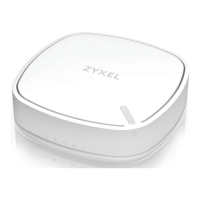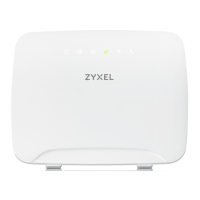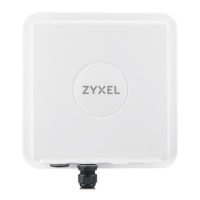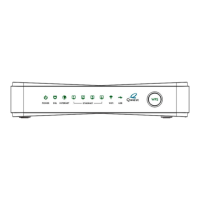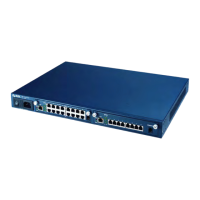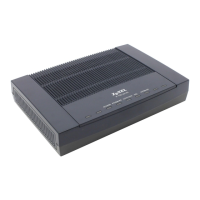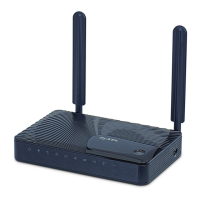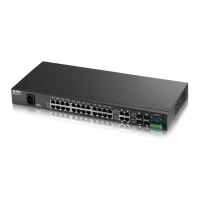
Do you have a question about the ZyXEL Communications MES3500 Series and is the answer not in the manual?
| Product Series | MES3500 Series |
|---|---|
| Device Type | Managed Ethernet Switch |
| Layer | Layer 2 |
| Power over Ethernet (PoE) | Yes (on select models) |
| Quality of Service (QoS) | 8 priority queues |
| Security Features | ACLs |
| Management | Web GUI, CLI, SNMP |
| Jumbo Frame Support | Up to 9KB |
| Power Supply | Internal AC power supply |
| Operating Temperature | 0°C to 40°C |
| Storage Temperature | -40°C to 70°C |
Introduces the main features and applications of the Switch, covering models, management methods, and network environments.
Outlines various methods for managing the Switch, including Web Configurator, Command Line Interface, FTP, and SNMP.
Provides essential practices for maintaining Switch security and efficient management, such as password policies and configuration backups.
Describes the different placement options for the Switch: desktop, rack, or wall mounting, including ventilation requirements.
Provides step-by-step instructions for installing the Switch on a desktop surface, emphasizing stability and clearance.
Details the process for mounting the Switch into a standard EIA 19-inch rack, including necessary hardware and precautions.
Explains how to mount the Switch on a wall, including selecting a suitable location and marking screw positions.
Describes the components and ports found on the front panel of the Switch, including LEDs, Ethernet ports, and console port.
Details the function and status indication of each LED on the Switch for operational monitoring and troubleshooting.
Introduces the HTML-based Web Configurator for Switch setup and management via a web browser.
Guides users on how to access the Web Configurator by entering the Switch's IP address and logging in.
Explains the navigation panel and key components of the Web Configurator interface for managing the Switch.
Details how to save configuration changes to the Switch's nonvolatile memory to ensure persistence after reboot.
Describes methods to prevent unauthorized access to the Switch via in-band management, potentially locking oneself out.
Provides instructions on how to reload the factory-default configuration file or reset the Switch to its factory defaults.
Recommends logging out after a management session for security reasons and explains the process.
Explains how to access the web configurator's online help for descriptions of screens and supplementary information.
Lists the configuration steps for initial setup: creating a VLAN, setting port VLAN ID, and configuring the Switch IP address.
Demonstrates how to configure the Switch's management IP address, possibly in a different subnet for management purposes.
Provides a step-by-step guide on configuring DHCP snooping to manage IP address assignments and enhance network security.
Explains how to configure the Switch to forward DHCP client requests to a specific DHCP server for IP address assignment.
Details the configuration of PPPoE Intermediate Agent to pass subscriber information to a PPPoE server for identification and authentication.
Illustrates how to configure the Switch to shut down a port upon detecting errors like loops or excessive ARP requests.
Guides on setting up a guest VLAN for unauthenticated clients, providing limited network access like internet surfing.
Explains how to prevent inter-port communication within a VLAN using private VLANs while allowing uplink access.
Describes how the web configurator's home screen displays port statistics and links to detailed port information.
Explains how to view port statistics by accessing the Status screen, providing a summary of link status and traffic.
Allows checking firmware version, monitoring Switch temperature, and voltage, and viewing system hardware information.
Guides on configuring general settings like system name, location, contact person, and time server synchronization.
Explains Virtual Local Area Networks (VLANs), their benefits for network segmentation, isolation, and performance.
Covers configuring global switch parameters including VLAN type (802.1Q or Port Based), MAC learning, and smart isolation.
Details configuring the Switch IP address, default gateway, DNS server, and management VLAN ID for network access.
Explains how to configure individual Switch port settings such as speed, duplex mode, flow control, and 802.1p priority.
Introduces IEEE 802.1Q tagged VLANs, explaining VLAN membership, tagging, and frame format for network segmentation.
Describes automatic VLAN registration using GARP and GVRP protocols for dynamic VLAN membership across switches.
Explains how to enable VLAN Trunking to allow frames belonging to unknown VLAN groups to pass through intermediary devices.
Instructs on selecting the VLAN type (802.1Q or Port Based) in the Switch Setup screen for VLAN configuration.
Details how to configure static VLANs to control frame forwarding based on VLAN tags, group membership, or blocking.
Explains how to group traffic into logical VLANs based on source IP subnet for traffic prioritization and management.
Describes grouping traffic into logical VLANs based on specified protocols like ARP or AppleTalk for traffic prioritization.
Explains how to assign incoming untagged packets to a VLAN based on the source MAC address for port-based traffic classification.
Details how to set MAC address learning limits on a per-port and per-VLAN basis for controlling dynamic MAC entries.
Guides on setting up port-based VLANs where forwarding decisions are based on destination MAC address and associated port.
Introduces configuring forwarding rules based on MAC addresses of devices on the network for static MAC address forwarding.
Explains how to manually enter static MAC addresses into the MAC address table for port-specific forwarding rules.
Provides an overview of static multicast forwarding, allowing administrators to forward multicast frames to specific ports.
Details how to configure rules to forward specific multicast frames, such as streaming or control frames, to specific ports.
Explains how to configure the Switch to filter traffic based on source, destination MAC addresses, or VLAN group (ID).
Provides an overview of Spanning Tree Protocol (STP), Rapid Spanning Tree Protocol (RSTP), and Multiple Spanning Tree Protocol (MSTP).
Describes the Spanning Tree Protocol status screen, which displays information based on the chosen STP standard.
Explains how to activate one of the STP modes (RSTP, MRSTP, MSTP) on the Switch via the Spanning Tree Configuration screen.
Guides on configuring RSTP settings, including bridge priority, hello time, and port configurations.
Details the RSTP status screen, showing bridge information, hello time, max age, and forwarding delay settings.
Explains how to configure MRSTP, including activating STP trees and assigning ports to specific spanning trees.
Describes the MRSTP status screen, providing information on bridge IDs, hello times, and maximum age settings.
Guides on configuring MSTP, including settings for MST regions, instances, and port configurations.
Defines bandwidth control as setting maximum allowable bandwidth for incoming and outgoing traffic flows on a port.
Details how to configure bandwidth control settings via the Bandwidth Control screen, including CIR and PIR.
Explains how to configure broadcast storm control to limit broadcast, multicast, and DLF packets per second on ports.
Introduces port mirroring for copying traffic flows to a monitor port for examination without interfering with network traffic.
Describes the screen for configuring local port mirroring, allowing selection of monitor ports and traffic direction.
Explains how to set the RMirror VLAN ID and mirroring port for remote port mirroring when the Switch is the source device.
Details specifying the RMirror VLAN ID and monitor port for remote port mirroring when the Switch is the destination device.
Explains link aggregation (trunking) as grouping physical ports into a single logical, higher-bandwidth link.
Describes dynamic link aggregation using LACP, allowing automatic negotiation and management of trunk groups.
Explains how to view the status of link aggregation, including group ID, enabled ports, and synchronized ports.
Guides on configuring static link aggregation, including group ID, active status, and traffic distribution criteria.
Details the configuration of LACP for dynamic link aggregation, including system priority and LACP active settings.
Provides an example of creating a static port trunk group for ports 2-5, including physical connections and configuration.
Introduces port authentication for validating client access based on external servers using IEEE 802.1x and MAC authentication.
Guides on activating port authentication methods and configuring RADIUS server settings in the AAA section.
Explains port security allowing only packets with learned or static MAC addresses to pass through a port.
Details how to set up port security, including enabling the feature, disabling MAC learning, and configuring static MAC addresses.
Defines a profile as saved settings for ranges of ports, IP addresses, VLANs, or socket ports, usable across multiple screens.
Describes accessing and configuring profiles for VLANs, IP addresses, ports, and socket ports via the Range Profile screen.
Explains how to view, manage, and create VLAN range profiles, specifying ranges of VLAN IDs for identification purposes.
Guides on viewing, managing, and creating port range profiles, specifying ranges of port numbers for configuration.
Details viewing, managing, and creating IP address range profiles, specifying ranges of IP addresses for configuration.
Explains how to view, manage, and create socket port range profiles, specifying ranges of socket port numbers.
Introduces Classifiers and Quality of Service (QoS) for prioritizing traffic and fine-tuning network performance.
Details how to define classifiers to specify actions (policy) on traffic matching specific rules.
Explains how to view a summary of classifier configurations and edit existing rules for traffic classification.
Provides an example of configuring a classifier to identify traffic based on MAC address and port.
Explains how classifiers distinguish traffic flows and policy rules ensure requested treatment within the network.
Guides on configuring policy rules, which define actions for classified traffic flows, after setting up classifiers.
Describes how to view a summary of policy configurations and edit existing rules for traffic treatment.
Illustrates configuring a policy to limit bandwidth on a traffic flow classified using a specific example classifier.
Introduces queuing methods used to solve performance degradation during network congestion and configure outgoing traffic.
Details how to configure queuing methods like SPQ, WFQ, and WRR on the Switch for traffic management.
Explains VLAN stacking for distinguishing multiple customer VLANs within a network by adding outer VLAN tags.
Describes the three VLAN stacking roles: Normal, Access Port, and Tunnel Port for frame switching and tag handling.
Details the format of a VLAN tag, including Type, Priority, and VID fields used in service provider VLAN stacking.
Guides on configuring VLAN stacking settings, including port roles and tunnel TPID values for frame encapsulation.
Introduces multicast transmission, IGMP, IP multicast addresses, and IGMP filtering features for efficient group communication.
Explains how to view multicast group information and configure multicast settings via the Multicast Status screen.
Describes Multicast VLAN Registration (MVR) for sharing a single multicast VLAN among different subscriber VLANs.
Guides on creating multicast VLANs and configuring receiver and source ports for each multicast VLAN using the MVR screen.
Explains the AAA process: authentication, authorization, and accounting for user access and activity tracking on the Switch.
Details the AAA screens for enabling authentication, authorization, and accounting, and configuring server settings.
Lists RADIUS attributes used for defining authentication and accounting elements in user profiles on the RADIUS server.
Explains IP Source Guard's use of a binding table to filter unauthorized DHCP and ARP packets, distinguishing authorized and unauthorized traffic.
Describes viewing current bindings for DHCP snooping and ARP inspection, which distinguish authorized and unauthorized packets.
Guides on managing static bindings for DHCP snooping and ARP inspection, uniquely identified by MAC address and VLAN ID.
Details how to view statistics about the DHCP snooping database, including agent URL and database file format.
Explains enabling DHCP snooping on the Switch and configuring the database location and update intervals.
Describes viewing statistics about ARP packets in each VLAN and MAC address filters created due to unauthorized ARP packets.
Explains Loop Guard's function to shut down ports detecting looped-back packets, protecting the network edge.
Guides on enabling Loop Guard on the Switch, including port settings and generating syslog/SNMP traps on port shutdown.
Explains VLAN mapping to map VLAN IDs and priorities from private networks to service provider networks.
Instructs on enabling VLAN mapping on the Switch via the VLAN Mapping screen.
Details how to enable and edit VLAN mapping rules, specifying port, VID, translated VID, priority, and direction.
Introduces Layer-2 protocol tunneling (L2PT) for service provider edge devices to tunnel L2 protocols like STP and CDP.
Guides on configuring L2PT, including port modes (Access, Tunnel) and supported protocols like STP, LACP, VTP, CDP, UDLD, PAGP.
Describes sFlow (RFC 3176) as a technology for monitoring switched networks by sampling traffic data.
Details how to configure sFlow ports for traffic monitoring, specifying sample rate and poll interval to send datagrams to a collector.
Introduces PPPoE Intermediate Agent (PPPoE IA) for adding subscriber information to PPPoE discovery packets.
Explains how to configure the PPPoE Intermediate Agent on the Switch via the PPPoE screen.
Details configuring the Switch to provide subscriber information to a PPPoE server for client identification and authentication.
Explains CPU protection for limiting control packet rates (ARP, BPDU, IGMP) to prevent CPU overload and DoS attacks.
Describes error-disable recovery features that allow automatic port activation after an error condition is resolved.
Guides on configuring error disable related settings, including CPU protection, errdisable detect, and recovery.
Explains how to view the Switch's detected control packet rate limits and port status (disabled or forwarding).
Details limiting control packet rates on ports for CPU protection and selecting actions when limits are exceeded.
Guides on configuring the Switch to detect exceeded rate limits for control packets and take corresponding actions.
Explains how to configure the Switch to automatically undo actions after an error condition is gone, specifying time intervals.
Introduces Private VLAN for port isolation within a VLAN, blocking traffic between isolated ports while allowing promiscuous port access.
Guides on configuring and enabling private VLAN rules for VLANs to achieve port isolation within the network.
Explains how the Switch uses IP for communication and static routes for responding to unreachable management stations.
Details how to configure static routes in the IP Application > Static Routing screen for managing network traffic forwarding.
Introduces DiffServ (Differentiated Services) as a CoS model for marking packets with DSCPs for specific per-hop treatment.
Explains traffic policing methods like TRTCM for limiting traffic rates based on CIR and PIR, marking packets with colors.
Guides on activating DiffServ to apply marking rules or IEEE 802.1p priority mapping on selected ports.
Introduces DHCP for obtaining TCP/IP configuration, allowing the Switch to act as a server or relay agent.
Explains DHCP configuration options divided into Global and VLAN screens for offering DHCP services to clients.
Describes the DHCPv4 Status screen, showing configuration settings related to the Switch's DHCP relay mode.
Guides on configuring DHCP relay to help forward network information between DHCP clients and servers not in the same domain.
Explains DHCPv6 relay agent functionality for forwarding messages between DHCPv6 servers and clients, including option 82 information.
Introduces Address Resolution Protocol (ARP) for mapping IP addresses to MAC addresses and maintaining the ARP table.
Details configuring each port's ARP learning mode (ARP-Reply, Gratuitous-ARP, ARP-Request) for updating the ARP table.
Explains how to manage firmware and configuration files, including upgrade, restore, backup, and factory default loading.
Provides instructions to reset the Switch back to its factory default configuration settings.
Details how to save current configuration settings permanently to Configuration 1 or Configuration 2 on the Switch.
Explains how to restart the Switch without physical power cycling, allowing loading of specific configurations upon reboot.
Guides on uploading the correct model firmware to the Switch, emphasizing the importance of using the right version.
Describes how to restore a previously saved configuration file from a computer to the Switch.
Explains how to create 'snap shots' of the Switch configuration to a computer for later restoration.
Introduces the Tech-Support feature for logging useful information like CPU utilization and crash reports for issue analysis.
Provides examples of uploading or downloading files from the Switch using FTP commands, including filename conventions.
Describes how to control access to the Switch via console port, Telnet, SSH, FTP, Web, and SNMP sessions.
Shows the main Access Control screen where users can access SNMP, Logins, Service Access Control, and Remote Management.
Introduces Simple Network Management Protocol (SNMP) for managing and monitoring TCP/IP-based devices.
Guides on setting up login accounts for administrators and non-administrators to access the Switch via web configurator.
Explains SSH (Secure Shell) as a secure protocol for encrypted communication, authentication, and file transfer.
Summarizes the process of establishing a secure connection between two remote hosts using SSH.
Details the Switch's support for SSH version 2, including authentication methods and encryption algorithms.
Explains HTTPS as a web protocol for secure web page encryption and decryption using SSL/TLS.
Provides examples of accessing the Switch via HTTPS, including handling browser security certificate warnings.
Describes controlling access to the Switch by enabling/disabling services and configuring trusted computers for each service.
Explains configuring trusted computers for remote management services like Telnet, HTTP, and SSH.
Explains the Diagnostic screen for checking system logs, pinging IP addresses, and performing port tests to identify problems.
Introduces the syslog protocol for sending event notification messages to syslog servers for collection and analysis.
Guides on configuring system logging settings to send logs to an external syslog server.
Details configuring a list of external syslog servers, specifying IP address, log level, and activation status.
Introduces cluster management for managing multiple switches through one Switch (cluster manager).
Explains how to view cluster management status, including manager details, member count, and member status (online, error, offline).
Guides on configuring clustering management, including setting the cluster manager and managing cluster members.
Introduces the MAC Table screen, showing how frames are forwarded or filtered based on MAC addresses and VLAN groups.
Details how to view the MAC Table, specifying conditions and sort order for displaying MAC address entries.
Introduces the ARP Table, which maps IP addresses to MAC addresses and maintains associations for local area network communication.
Guides on using the ARP table screen to view IP-to-MAC address mappings and remove specific dynamic ARP entries.
Explains how to copy basic and advanced settings from a source port to destination ports using the Configure Clone screen.
Provides troubleshooting steps for issues related to power, hardware connections, and LED behavior.
Offers solutions for problems related to forgetting IP addresses, usernames, passwords, or accessing the web configurator.
Addresses issues with losing configuration settings after restarting the Switch and ensures proper saving of configurations.

